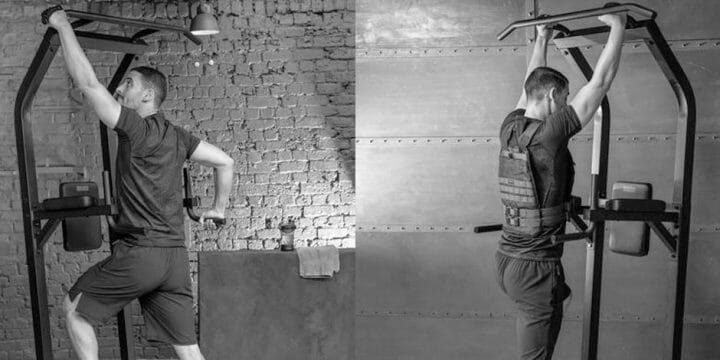In my experience as a health and performance coach, I've seen numerous athletes successfully incorporate resistance bands into their cardio and strength routines, a practice backed by expert opinions and scientific research for its effectiveness in shoulder workouts.
Ideal for counteracting the effects of prolonged slouching over laptops or phones, these exercises build strong shoulder muscles and joints, enhance flexibility, and alleviate neck and shoulder pain. They also help prevent injuries, correct poor posture, and address muscle imbalances.
Here are the best options.
Quick Summary
- To build mass in shoulder muscles, incorporating resistance band exercises into your workout routine is highly effective, as confirmed by both expert opinions and scientific research.
- These resistance band exercises are particularly beneficial for counteracting the negative effects of prolonged slouching, improving posture, and addressing muscle imbalances.
- The Physical Therapy and Rehabilitation journal highlights that lateral raises with resistance bands require lighter loads (3–10 kg) compared to classic shrug exercises (20–30 kg), demonstrating their efficiency and safety for muscle development.
- In my experience, coupling resistance band shoulder exercises with a good-tasting protein intake post-workout is a powerful combination for athletes to build shoulder mass and aid recovery.
1. Single-Arm Band Shoulder Press
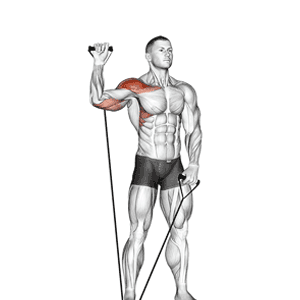
Stand straight on the resistance band with your right foot.
Hold the other end of the band in your right hand behind your arm, with your palm facing forward, elbow down and close to your body, and wrist directly above it.
With your core engaged, press the band upwards until the full elbow lockout. Hold for a moment and slowly return to the starting position. Repeat, then switch sides.
From my coaching perspective, the one-arm band shoulder press demands greater core engagement for stability and spine alignment, more so than the two-arm version.
It’s also better than a dumbbell shoulder press because resistance bands don’t create momentum and are gentle on the spine and joints (unlike free weights).
Targeted muscles: delts (front, middle, and rear), triceps, pecs
Do 3–4 sets of 20 reps per side.
2. Front Raise
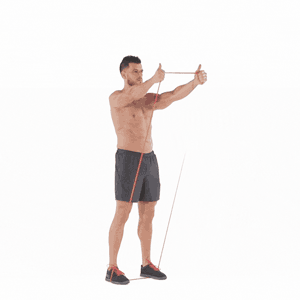 Stand upright on one end of the resistance band with your feet shoulder-width apart, core tight, and shoulders squeezed back.
Stand upright on one end of the resistance band with your feet shoulder-width apart, core tight, and shoulders squeezed back.
Hold the other end of the band in an overhand grip with both hands shoulder-width apart, slightly bent in the elbows.
Lift your arms straight in front of you up to your shoulder height, and hold for a second before returning to the starting position.
Don’t use the momentum to lift the band. Avoid shrugging your shoulders or rocking the body back and forth, ensuring that you feel the tension and burn throughout the movement.
This exercise is also great for pumping up your front delts.
Targeted muscles: delts (front, middle), biceps, serratus anterior
Do 3 sets of 20 reps.
3. Single-Arm Band Lateral Raise
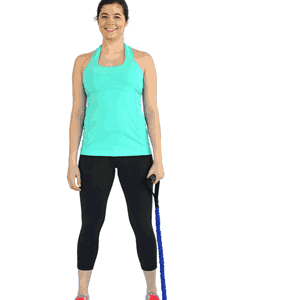
Loop the band around your left foot once (or twice for higher resistance) and stand straight.
Hold the other end of the band in your right hand with your palm facing in and your arms straight.
Lift your right arm out to the side in a controlled motion until you pull the band up to your shoulder height, ensuring that your palms are facing parallel to the floor.
Hold the band for a second and then return it to your side slowly. Switch sides when you complete all the reps on the right side.
This exercise is also a good choice during the rehabilitation process.
As demonstrated in the study published in the Physical Therapy and Rehabilitation journal, lateral raises require lighter training loads (3–10 kg) compared to shrug exercises (20–30 kg), offering a more manageable alternative for individuals dealing with chronic muscle pain [1].
Targeted muscles: delts (middle)
Do 3 sets of as many lateral raises as possible (at least 20 per side).
If you can’t do some extra reps, increase the resistance to push yourself harder.
“With bands, you can safely go past thresholds without injuring yourself and impairing the joints.”
- David Morin, Fitness Model
4. Pull Apart
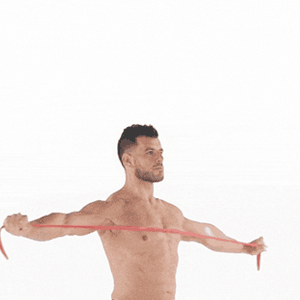 Standing upright, hold the band in an overhand grip with your elbows unlocked, chest up, and your arms shoulder-width apart and extended horizontally out in front of you at shoulder height.
Standing upright, hold the band in an overhand grip with your elbows unlocked, chest up, and your arms shoulder-width apart and extended horizontally out in front of you at shoulder height.
Pull the band apart, separating your hands to the side as far as you can and squeezing your shoulders together, as noted in the International Journal of Sports Physical Therapy [2].
Hold for a moment, then return to the starting position slowly.
Targeted muscles: delts (rear), traps, rhomboids, and rotator cuffs
Do 3 sets of 15 reps.

5. Upright Row
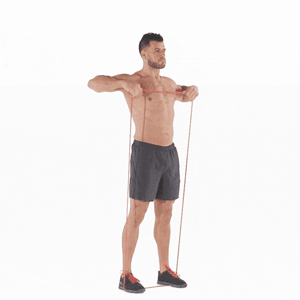
Stand on one end of the loop with your feet shoulder-width apart, your core engaged, and your spine neutral. (You can wrap the band around your feet to increase resistance.)
Hold the other end of the band with both hands shoulder-width apart, with palms facing inward in front of your waist.
Pull the resistance band straight up to about your upper chest level, raising your elbows high above your hands and squeezing your shoulder blades.
Then, release the band, slowly back down, and repeat.
During the upright row, I always advise maintaining a straight posture and soft knees to reduce lower back strain, a technique I've emphasized in my coaching.
Targeted muscles: delts (front, middle), traps, upper back
Do 3 sets of 15-20 reps.
Related: 10 Best Middle Delt Exercises
6. Banded Shrug
 Stand straight in the middle of the band with your feet shoulder-width apart, holding the band ends in each hand with your arms relaxed.
Stand straight in the middle of the band with your feet shoulder-width apart, holding the band ends in each hand with your arms relaxed.
In my training sessions, I emphasize shrugging the shoulders high in banded shrugs to maximize trap engagement. Hold for a second and lower your shoulders back.
Targeted muscles: traps, rhomboids
Do 3 sets of 15 reps.
Other types of band exercises:
7. Reverse Fly
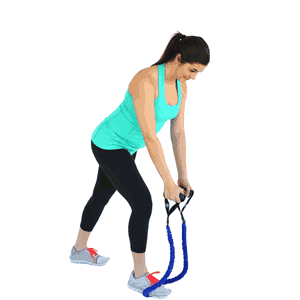
Stand in the center of the resistance band with both feet hip-width apart.
Slightly lean forward, holding the bend ends in each hand while keeping your upper back, neck, and head in a straight line.
Pull the band apart, raising it with both arms stretched out wide. Squeeze the shoulder blades to ensure a full range of motion.
Hold the band briefly at the top. Then, lower it down slowly and repeat.
The reverse fly exercise helps to strengthen all the major muscles for proper muscle balance and upright posture.
Which further helps relieve chronic neck and shoulder pain in no time, based on British Journal of Sports Medicine research [3].
You can also try reverse cable flies for rear delts as an alternative, in case you don't have a band.
Targeted muscles: delts (rear), traps (middle and lower), rhomboids
Do 3 sets of 20 reps.
8. Banded Y-Fly
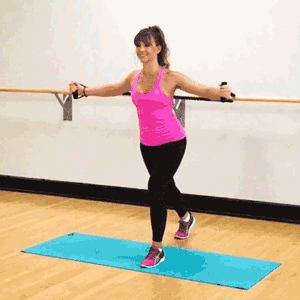 Loop one end of the resistance band around a pole at your upper chest level.
Loop one end of the resistance band around a pole at your upper chest level.
Hold the other band end in an overhand grip with both hands around shoulder-width apart and slightly turned, with your thumbs pointing downwards.
Stand upright with your core engaged, lifting your hands up and back to form a Y-shape.
Pause briefly before bringing them back down.
Targeted muscles: delts (front, middle), rhomboids
Do 3 sets of 10 reps.
9. Kneeling Superman
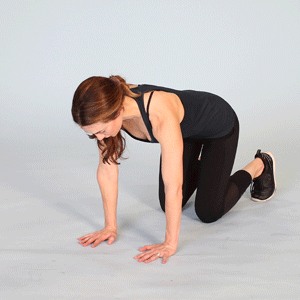
Kneel on the floor on all fours with your back slightly curved inward.
Chin tucked, elbows flexed somewhat, knees under your hips, hands beneath your shoulders, and the resistance band looped around your right foot and left hand.
Raise your left hand and right foot as high as you can to stretch the band tautly underneath your body until you feel the contraction along your back.
Hold it briefly, and then return to the starting position. Repeat the same movement on both sides.
Targeted muscles: delts, traps, rhomboids, infraspinatus, teres minor
Do 3 sets of 10 reps.
10. Shoulder Dislocates
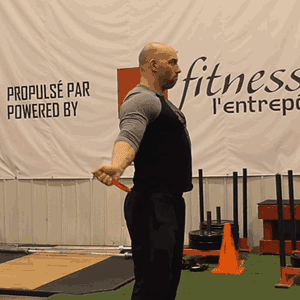 Start from a standing position with your feet shoulder-width apart and your arms and back straight.
Start from a standing position with your feet shoulder-width apart and your arms and back straight.
Hold the ends of the band in front of your waist with both hands a bit wider than shoulder-width apart and slightly bent in the elbows.
Rotating your arms, pull the band up, overhead, and down to touch your lower back with it.
Then, pause for a second and rotate your arms back to the starting position (the front of your waist). Repeat.
In my professional practice, I've found Shoulder Dislocates to be an excellent warm-up for stretching shoulders and enhancing joint mobility across all fitness levels.
Targeted muscles: delts, pecs, triceps, and biceps
Do 3 sets of 10 reps.
Creating an Effective Resistance Band Home Gym Setup
Setting up a resistance band home gym? Start with a variety of bands differing in tension and length. You'll need sturdy door or wall hooks for setting up bands at various angles, mimicking cable machine exercises. Think lat-pulldowns from above!
Beyond the bands, grab some wall hooks for secure attachment, a comfy exercise mat for floor workouts, and maybe a workout bench for bench press and chest flyes-like movements.
To level up your resistance band shoulder exercises, increase band tension or the complexity of your moves. For an easier workout, go for lighter bands or simpler exercises, catering to all fitness levels.
Remember, secure those hooks well! I've seen some nasty bruises from bands snapping back due to flimsy hooks. And while bands are safer than free weights, always keep safety in mind.
References:
- https://academic.oup.com/ptj/article/88/6/703/2742306
- https://www.ncbi.nlm.nih.gov/pmc/articles/PMC8975561/
- https://bjsm.bmj.com/content/46/14/1004
About The Author
You May Also Like



